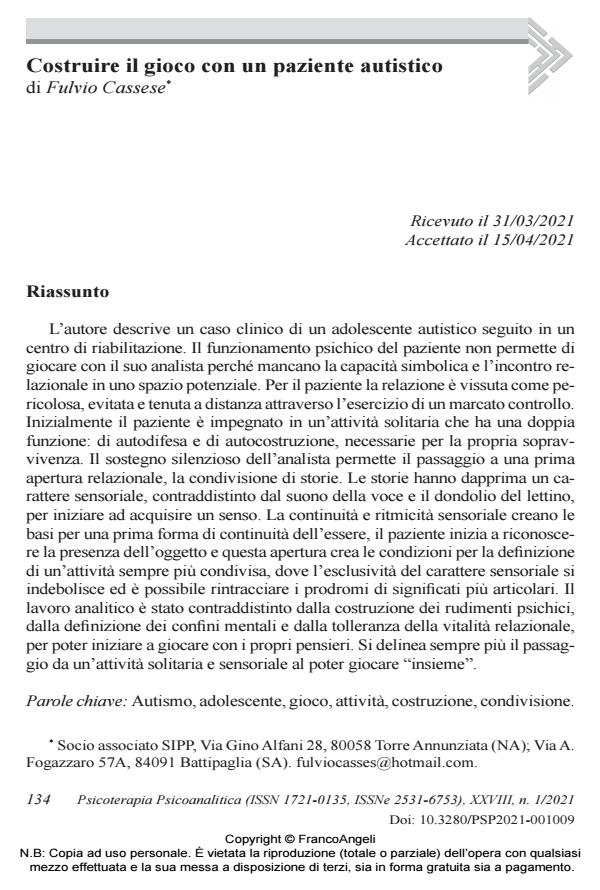Build the game with an autistic patient
Journal title PSICOTERAPIA PSICOANALITICA
Author/s Fulvio Cassese
Publishing Year 2021 Issue 2021/1 Language Italian
Pages 11 P. 134-144 File size 185 KB
DOI 10.3280/PSP2021-001009
DOI is like a bar code for intellectual property: to have more infomation
click here
Below, you can see the article first page
If you want to buy this article in PDF format, you can do it, following the instructions to buy download credits

FrancoAngeli is member of Publishers International Linking Association, Inc (PILA), a not-for-profit association which run the CrossRef service enabling links to and from online scholarly content.
The author describes a case report of an autistic teenager being treated in a rehabilitation center. The psychic functioning of the patient does not allow to play with his analyst because the symbolic capacity and the relationship in a potential space are lacking. For the patient, the relationship is experienced as dangerous, avoided and kept away with the use of great control. At the first time, the patient is engaged in a solitary activity that has a double function: self-defense and self-construction, necessary for his own survival. The analyst’s silent support allows the passage to a first relational opening, the sharing of stories. The stories first have a sensorial character, characterized by the sound of the voice and the rocking of the bed, to begin to acquire a sense. Sensory continuity and rhythmicity create the basis for a first form of continuity of being, the patient begins to recognize the presence of the object and this opening creates the conditions for the definition of an increasingly shared activity, where the exclusivity of the sensory character weakens and it is possible to trace the prodrome of more articular meanings. The analytic work was characterized by the construction of psychic rudiments, the definition of mental boundaries and the tolerance of relational vitality, in order to start playing with one’s thoughts. The transition from a solitary and sensorial activity to being able to play "together" is becoming more and more evident.
Keywords: Autism, teenager, play, activity, building, sharing
- Di Ciaccia A. (1973). Il seminario. Libro XX 1972-1973. Torino: Einaudi, 2011
- Egge M. (2006). La cura del bambino autistico. Roma: Astrolabio.
- Minkowski E. (1927). La schizofrenia. Torino: Einaudi, 1998
- Ogden T.H. (1989). Il limite primigenio dell’esperienza. Roma: Astrolabio, 1992.
- Ogden T.H. (1999). Soggetti dell’analisi. Milano: Masson, 1999.
- Winnicott D. (1971). Gioco e realtà. Roma: Armando, 2006
Fulvio Cassese, Costruire il gioco con un paziente autistico in "PSICOTERAPIA PSICOANALITICA" 1/2021, pp 134-144, DOI: 10.3280/PSP2021-001009